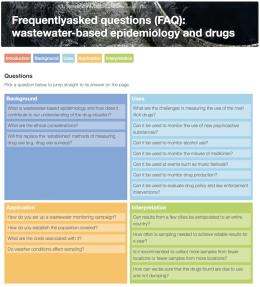Frequently asked questions (FAQ): wastewater-based epidemiology and drugs
Introduction
This list of frequently asked questions (FAQ) answers some of the common questions on the background, use, application and interpretation of wastewater-based epidemiology.
Wastewater analysis is a rapidly developing scientific discipline with potential for monitoring real-time data on geographical and temporal trends in illicit drug use. Originally used in the 1990s to monitor the environmental impact of liquid household waste, the method has since been used to estimate illicit drug consumption in various cities. It involves sampling a source of wastewater, such as a sewage influent to a wastewater treatment plant. This allows scientists to measure the levels of illicit drugs and their metabolites excreted in urine, which can then be used to estimate the quantity of drugs consumed by a community. This provides a non-invasive, near-real-time analysis of drug use within the area served by the sewer network.
Table of contents
- What is wastewater-based epidemiology and how does it contribute to our understanding of the drug situation?
- What are the ethical considerations?
- Will this replace the ‘established’ methods of measuring drug use (e.g. drug use surveys)?
- What are the challenges in measuring the use of the main illicit drugs?
- Can it be used to monitor the use of new psychoactive substances?
- Can it be used to monitor alcohol use?
- Can it be used to monitor the misuse of medicines?
- Can it be used at events such as music festivals?
- Can it be used to monitor drug production?
- Can it be used to evaluate drug policy and law enforcement interventions?
- How do you set up a wastewater monitoring campaign?
- How do you establish the population covered?
- What are the costs associated with it?
- Do weather conditions affect sampling?
- Can results from a few cities be extrapolated to an entire country?
- How often is sampling needed to achieve reliable results for a year?
- Is it recommended to collect more samples from fewer locations or fewer samples from more locations?
- How can we be sure that the drugs found are due to use and not dumping?









